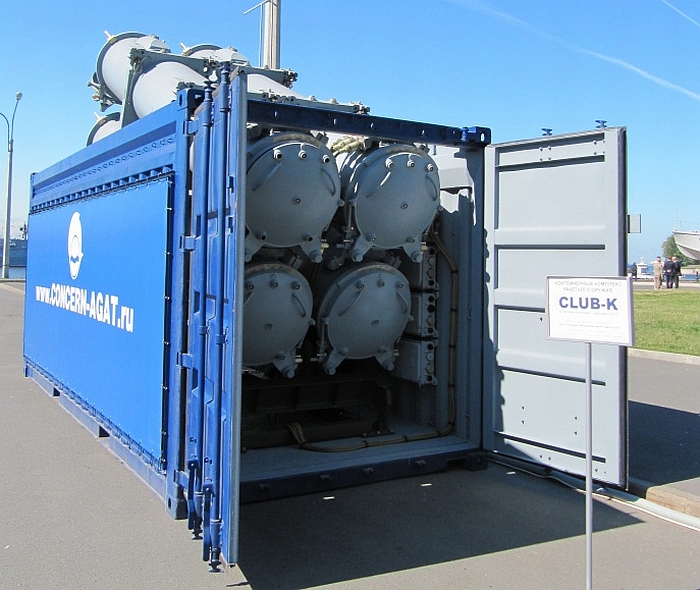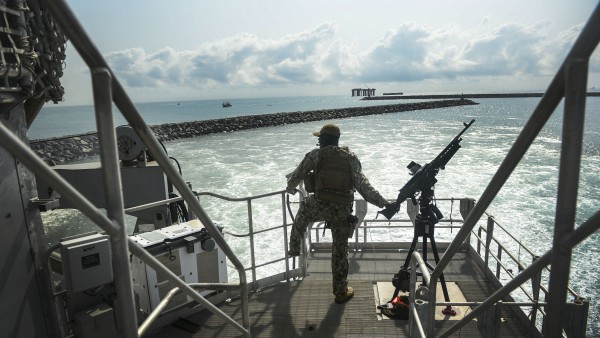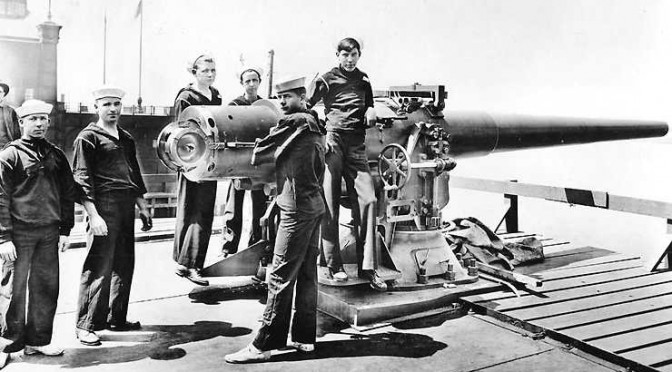Distributed Lethality Topic Week
By Chris Rawley
In simplest terms, the U.S. Navy’s distributed lethality concept complicates the enemy’s targeting problem by dispersing larger numbers of platforms capable of offensive action over a wide geographic area. With no significant increases in fleet size anticipated for the foreseeable future, it is incumbent that all avenues be pursued that will optimize the use of scarce ships.
[otw_shortcode_button href=”https://cimsec.org/buying-cimsec-war-bonds/18115″ size=”medium” icon_position=”right” shape=”round” color_class=”otw-blue”]Donate to CIMSEC![/otw_shortcode_button]
A video recently released by the Surface Force U.S. Pacific Fleet shows a variety of ships besides surface combatants equipped with anti-ship missiles and unmanned aircraft capable of targeting these weapons. In addition to amphibious vessels, a Lewis and Clark Dry Cargo/Ammunition ship is depicted (minute 1:21) with a drop-in missile module. This ship, and 29 others in the U.S. Navy’s Combat Logistics Force (CLF), are controlled by the Military Sealift Command (MSC) and manned by professional civilian mariners (CIVMARS). The introduction of armed naval auxiliaries in the U.S. fleet would raise a number of important operational and legal questions.
https://www.youtube.com/watch?v=21dFaIIeXpU
In what sort of tactical situations might an offensively-armed replenishment ship be worthwhile? Distributed lethality requires distributed logistics. Meaning, surface combatants operating alone or in small groups will require fuel, food, ammunition, and parts. In a major theater war, traditional replenishment ports will be placed at risk by mines, theater ballistic missiles, terrorist surrogates, and other area-denial capabilities. To mitigate these risks, underway replenishment has been a mainstay of U.S. naval surface ship operations for nearly a century. A CLF ship armed with self-defense weapons and a small number of medium ranged surface-to-surface missiles operating in tandem with a group of cruisers and destroyers (CRUDES) provides additional magazine capacity for the surface combatants.
Conversely, oilers operating solo while transiting to or from underway replenishment stations are an appetizing target for would-be adversaries. In some cases, these ships would require a dedicated “shotgun” surface combatant to protect their precious cargoes. But these escorts would take scarce CRUDES ships away from other offensive duties. CLF ships equipped with additional self-defense weapons, be they remotely-operated crew served machine guns or short-ranged surface-to-air missiles (like the SeaRAM), will enable defense against a variety of potential attackers. However, the possibility that CLF ships are capable of not just defending themselves, but of fighting back, will challenge indirect enemy strategies that rely on attrition of our logistic forces. A CLF ship would target its over-the-horizon weapons by either cueing off another platform’s sensors or using organic manned or unmanned aircraft. These ships sometimes deploy with MH-60s, which can carry their own weapons, but can also assist in targeting a ship’s missiles. For longer ranges, future unmanned air vehicles such as DARPA’s TERN prototype could support CLF-launched missile engagements over hundreds of miles. Besides the aforementioned weapons, CLF ships providing replenishment operations within adversary threat envelopes will need to employ counter-targeting techniques and some will carry Surface Ship Torpedo Defense Systems.
Non-traditional or Normal?
I’ve been guilty of using the phrase “non-traditional” naval vessels when referring to auxiliaries engaged in naval operations other than logistics. A recent example would be MSC’s Expeditionary Fast Transports serving as Partnership Station platforms. Historically, however, civilian-run shipping has been integral to naval warfare for as long as humankind has fought on the seas. Lincoln Paine discusses a number of non-traditional fleets in The Sea and Civilization, an amazingly comprehensive chronology of all aspects of maritime trade and warfare. In lieu of a powerful navy, the early Roman Empire established coloniae maritimae (maritime colonies), which exempted their men from service in the legions in exchange for their promise to destroy invading enemy vessels. A millennium later, Byzantium held off Muslim invaders at sea with a largely provisional force of merchants and fishermen. In the 19th Century, pirates turned privateers were engaged as naval commerce raiders by various states including Spain, Mexico, and the Republic of Texas.
In World War I, the British Admiralty encouraged merchant vessels to arm themselves with deck guns, ostensibly for the purposes of defense. Some of these merchants took it upon themselves to actively attack German shipping, often using false flags. The German Empire, as one might expect, grew to view these vessels as belligerents, rather than as neutral shipping, a role they were initially accorded by international law. Then in World War II, thousands of American merchant ships were protected by Naval Armed Guards, who manned anti-aircraft weapons and up to 3″ deck guns. Merchant mariners supported these gun crews by passing ammunition, but were also trained to employ the weapons when necessary, and many did so, distinguishing themselves in battle.

More recently, we’ve watched the emergence of China’s rather sizable maritime militias, which are a key aspect of the PLAN’s expansion strategy in the South China Sea. These sorts of maritime surrogates have kept up with changing naval technology. Today, instantaneous data communications have made over-the-horizon networked targeting by civilian craft a distinct possibility. Additionally, concealable anti-ship weapons, such as Russia’s Club-K containerized missile system, could raise the threat posed by merchant shipping. These non-traditional fleets are not anomalies, but rather mainstays of offensive naval warfare. How does this historical reality reconcile with modern legal norms of international armed conflict?
Nuances Riding on a Single Letter
Traditional prohibitions against civilians taking a direct part in hostilities are based on a duty to discriminate between combatants who may be lawfully targeted and non-combatants who may not be intentionally targeted. International humanitarian law is also designed to protect duly-recognized combatants from prosecution and provide for status as prisoners of war. In modern times, these distinctions have been interpreted to prohibit civilians aboard a warship from serving as a weapons release authority or standing tactical watches. Besides CIVMARS, a host of civilians routinely ride naval ships, including maintenance contractors, college instructors, and Morale, Welfare, and Recreation planners; all of course, in non-tactical roles.

To understand the legal nuances behind arguments for and against non-traditional naval vessels undertaking offensive operations, it’s worth examining the distinction the U.S. Navy makes between warships and naval auxiliary vessels.[1] In accordance with Navy Regulations, Article 1259, a commissioned warship – designated USS – requires “a personal flag or command pennant of an officer of the Navy, or a commission pennant.” U.S. Naval Ships (USNS) operate under the control of civilian mariners, and therefore do not technically qualify as warships. Under the same regulations, in some circumstances, a USNS ship can be reclassified as a USS hull, but this requires approval by the Secretary of the Navy. These conventions are supported by Article 29 of the United Nations Convention on the Law of the Sea (UNCLOS), which states a warship is “a ship belonging to the armed forces of a State bearing the external marks distinguishing such ships of its nationality, under the command of an officer duly commissioned by the government of the State and whose name appears in the appropriate service list or its equivalent, and manned by a crew which is under regular armed forces discipline.” The 1994 San Remo Manual on International Law Applicable to Armed Conflicts at Sea also provides a non-binding, but widely-accepted view of naval auxiliaries in warfare.
Auxiliaries are vessels, other than warships, that are under the exclusive control of the armed forces of a state. Some interpretations of international law infer that naval auxiliaries (non-warships) may defend themselves and other friendly forces in the vicinity, but may not be used to conduct offensive belligerent acts. Under the strictest legal interpretations, MSC ships would be prohibited from a range of activities to include launching anti-ship weapons, but also to missions as innocuous and defensive as clearing a channel of mines for the safe passage of commercial shipping. International agreements are important, but we should not ignore historical precedence and operational necessity that may force auxiliaries into combat roles. As further precedence, not every vessel conducting offensive missions in the U.S. Navy meets the criterion required for warship. For example, combatant craft of the Navy’s Special Boat Teams and Coastal Riverine Squadrons are not commissioned warships, but may carry out offensive operations. Of course, these boats are run by Navy crews, and a commissioned officer resides at some point in their chain of command (though not always embarked).

Given generally-accepted views of international law, what are the alternatives available to include naval auxiliaries as offensives nodes in a distributed lethality regime? A handful of warships in the U.S. Navy, including USS Ponce (AFSB(I) 15), two flagships, and submarine tenders, feature a hybrid crewing model. These ships are commanded by a commissioned naval officer, though their navigation and engineering functions are primarily conducted by CIVMARs. This hybrid crewing approach enables them to conduct or command offensive operations in accordance with international law. Implementing this approach on a wider scale would require the reclassification of armed CLF ships to USS and the introduction of permanent Navy crews, an option not necessarily supported by today’s manpower budgets.
Embarking military detachments to operate defensive and offensive weapons might be another acceptable alternative. Over the past few decades, the combat logistics force has transitioned from USS ships, to USNS ships embarking military detachments (MILDETS) run by a junior surface warfare officer, and now to primarily USNS ships with no MILDETS. When embarked, MILDETS mostly handled command and control (C2) functions. Many of these roles have been absorbed by CIVMARS, but others, like operating self-defense weapons, are still supported by embarked Navy security teams. It’s possible that arming a CLF ship and operating its weapons systems with a MILDET, without reclassifying it as USS could put a ship’s status as naval auxiliary in jeopardy during hostilities. However, like merchant shipping that was targeted during the World Wars, that becomes largely an irrelevant academic argument once ordnance starts flying and logistics ships become primary targets themselves.
In an era of declining Navy end strength and increasing personnel costs, it is no longer fiscally prudent to assign full time military detachments to every ship that might require one in wartime. The Navy’s reserve component (RC) provides a feasible C2 alternative which can be surged forward during contingency operations, while meeting legal and operational requirements for offensive operations. In recent years, military detachments for theater security cooperation missions onboard MSC ships have been created ad hoc from cross-decked active duty Sailors or sourced from existing staffs such as Destroyer Squadrons. In the event of a major contingency, it is likely that these staffs will be tied up with their primary missions and unable to dedicate manpower to supporting auxiliary C2 requirements. In recognition of these demands, the Military Sealift Command recently established a dedicated Navy Reserve unit designed to provide C2 elements for MSC ships involved in non-logistics missions. This nascent capability has been demonstrated with embarked detachments onboard various MSC ships during fleet exercises and security cooperation missions.
The expansion of additional RC military detachments should be explored that support not only theater security missions, but future offensively-armed combat logistics force ships. The advantages of this capability residing in the reserve force are several: The first relates to cost. On average, a part-time reservist costs the navy approximately one fifth of an active duty Sailor. In peace-time, reservists would train for the mission by embarking CLF ships to support weapons testing and fleet exercises, and surge forward if required for contingency missions. Additionally, reserve Sailors, some of them with licensed merchant credentials themselves, have a strong knowledge of MSC ship unique operating procedures and understand how to integrate well with CIVMARs. The habitual relationships dedicated reserve units build with CIVMAR crews have proven valuable in other missions.
Regardless of whether the decision is made to increase the weapons capabilities of our Military Sealift Command ships, additional RC detachments would provide the legal and operational top-cover necessary to perform other traditional naval operations on these vessels in peace and war to include maritime security operations, mine-countermeasures, special operations direct action support, and amphibious raids.
Chris Rawley is a Captain in the U.S. Navy Reserve and serves as Commanding Officer for the Navy’s sole unit dedicated to providing command and control detachments aboard Military Sealift Command vessels. The opinions and views expressed in this article are those of the author alone and are presented in his personal capacity. They do not necessarily represent the views of U.S. Department of Defense, the U.S. Navy, or any other agency.
[otw_shortcode_button href=”https://cimsec.org/buying-cimsec-war-bonds/18115″ size=”medium” icon_position=”right” shape=”round” color_class=”otw-blue”]Donate to CIMSEC![/otw_shortcode_button]
[1] The author is not an operational law attorney. The reader is encouraged to seek out other legal interpretations.


Capt. Rawley,
Thank you for this important and timely article. With interesting budgetary times coming as debt service gobbles away with increasing voracity, “doing even more with even less” becomes an absolute necessity.
One day the green eyeshade contingent will seriously cast their collectively baleful eye upon sealift assets, in which case the Fast Sealift Ships could be looking iffy long term, what with large (41 souls last time I skippered one) complement and truly epic bunker consumption when flogged hard. It is possible, though, to cut that by 50-60% to dropping back to 21-23 knots on one boiler, versus 33 on both. In any event, to me at least it seems they would make a handy kind of a missile ship.
Heck, keep them on ROS except when training or crisis, as they have been. I’d hate to see that good German steel go to the breakers before its time. I know for a fact that somebody has done a study on changing their boilers for, as I recall, gas turbines, and the hulls were paid for a long time ago.